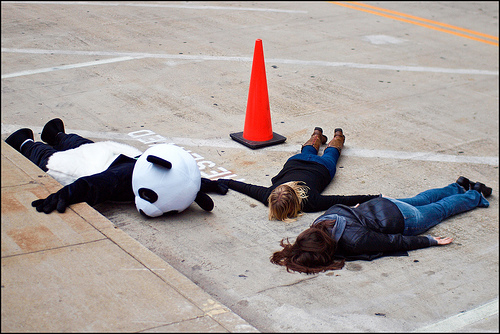Planks are really boring.
“Planking” is really stupid:
Planking is a photo fad which involves lying face down with arms to the sides in unusual public spaces, photographing the scene and sharing the image online. In form, it bears striking resemblance to the Lying Down Game, a similar photo fad that became popular among UK Facebook users in 2010.
But planks have value and even though they are boring as hell I still make people do them cause, plain and simple, they work. Problem is that after a couple of months most folks can hold a plank without any problem….for ……a ……..long……..time.
Yes, I used to make people do 2 minute long planks….To those clients: I’m sorry, that was stupid, you deserved better.
But I learned and thought about it and came up with a better way.
Now I have a progression that goes from the floor, no movement just holding the abdominal brace to coordinating movement (leg lifts) around a braced core to instability (Bosu) bracing in response to uninitiated movement to even more instability (physio ball) to active creation of movement in this highly unstable environment (ball push a-ways).
Essentially each step in the progression adds to the instability of the exercise increasing the demand on the “core” to lock the spine and hips into place.
Always keep in mind that the most important aspect of any plank is “tightness”. The low back, hips and shoulders should NEVER move.
The Basic Plank:
The basic plank is usually the very first exercise clients get in their core training progression. The basic plank is about learning how to keep a nice tight neutral spine under tension.
Key Points:
- Don’t suck in, try to “brace”/ flex the core.
- Don’t arch the low back excessively, keep the spine in “neutral” or even tilt the pelvis to the front slightly.
- The elbows should be at a 90 degree angle to the shoulder.
- Keep the head in line and chin tucked (don’t drop the head).
- Squeeze the butt (it helps “set” the core).
Progression #1: Alternating Leg lifts
Once the basic plank becomes too easy it becomes time to increase the challenge. I do this first by decreasing the number of contact points AND adding movement that I want to create. Why? Fewer contact points means that the core must work harder to keep the spine stable so that the hips don’t fall or rotate. Motion forces the core to learn to control movement while maintaining the active brace.
Key Points:
- Everything stays the same from the basic plank
- Squeeze the glute of the leg you are lifting. Try to lift by extending the hip NOT just bending the knee.
- Do not let the hips or shoulders rotate. They MUST stay locked in.
Progression #2: Bosu
Note: Basically the Bosu sucks, but for this it’s actually really awesome.
The Bosu allows us to get an unstable surface into the mix while still having a nice platform to set up on. Since the job of the “core” is to resist motion adding the Bosu makes sense because it will want to deform under pressure so you’ll have to control the motion by increasing “tightness” throughout the body.
Key Points:
- Try to keep the Bosu flat
Progression #3: Stability Ball Plank
The stability ball plank (done correctly) is fairly advanced. It takes a good amount of coordination and the genuine ability to “brace” the core, isometrically flexing the abs and glutes to limit movement. It also helps to have some upper body strength so that you’re actually able to keep the forearms on the ball and not have to dig the elbows into the ball to limit the movement of the ball.
This is what a Stability Ball Plank should look like:
Notice the forearms and wrists are the contact points.
This is not what should happen…but is ok the first couple times to get used to the movement, just don’t let yourself get comfortable with using the elbows as a crutch:
Wrists off the ball and elbows into the ball. Less than optimal but still better than on the floor.
Key Points:
- Keep tightness throughout the body. Squeeze everything!
- Keep the chest up, don’t round over.
- You can add stability by widening your stance.
- Forearms should provide pressure against the ball.
Bonus Super Hard advanced progression: Stability Ball Push-Aways
I’m not quite sure if these are actually planks. I mean, I think they are but typically in a plank the goal is to resist motion but by adding the push away we’re actually creating motion at the elbow. In many ways I think these are akin to the Stability Ball Plank as the HKC plank is to a regular plank. The variations (Ball plank Push-Aways and HKC plank) create a TON more tension than the basic version.
Key Points:
- Set up exactly as you would for a regular stability ball plank.
- Push the wrists into the ball, try to push “through” the ball.
- Maintain a perfectly straight line through the body, don’t let the chest round over as you push away.



